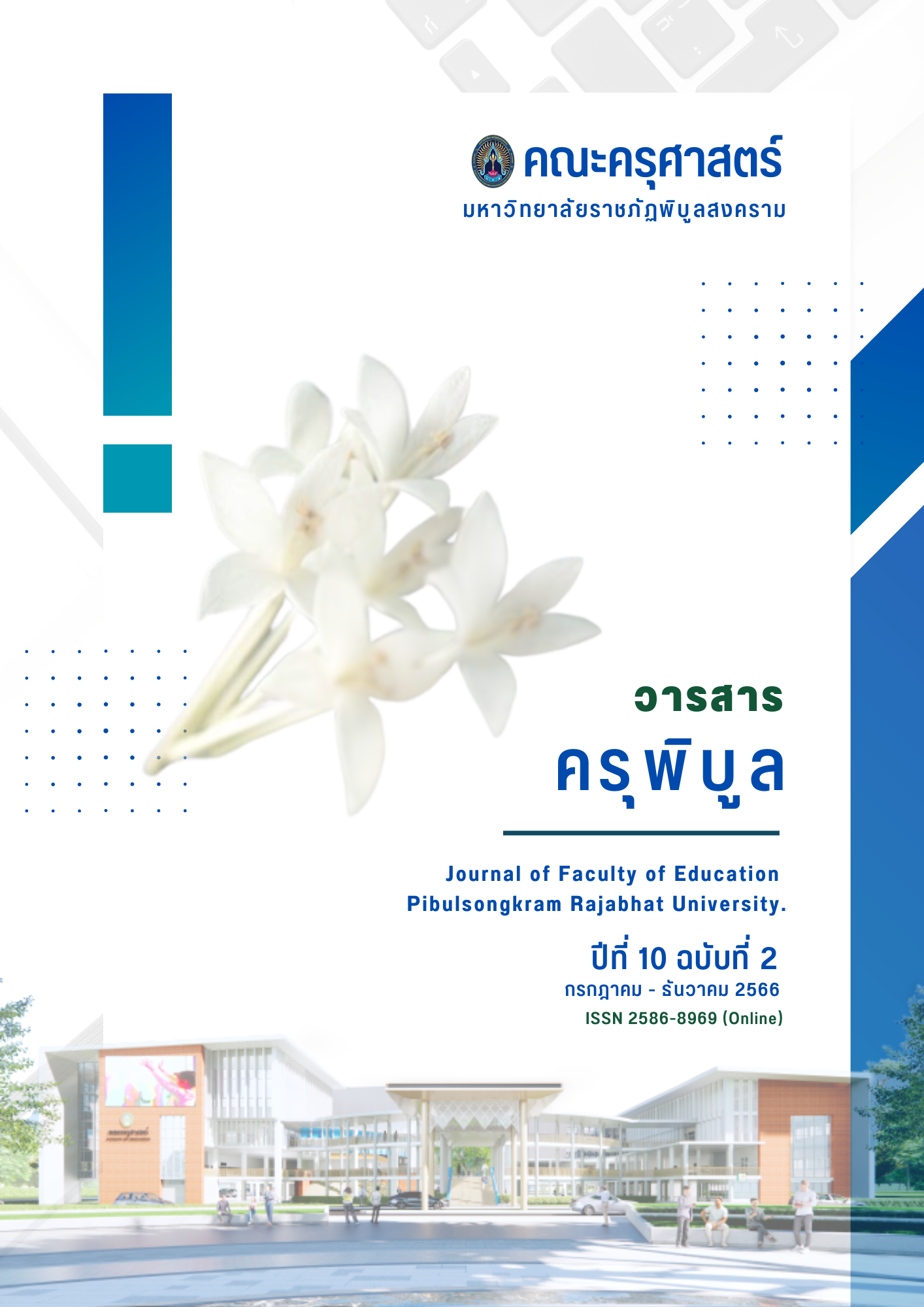MODELS OF ART TEACHER PROFESSIONAL STUDENTS TO ENHANCE ABILITIES IN LEARNING MANAGEMENT IN ARTS FOR STUDENT DIVERSITY IN INCLUSIVE CLASSROOM
Keywords:
art teacher professional students, art learning managementAbstract
This research and development aimed 1) to develop models of art teacher professional students to enhance abilities in learning management in arts for student diversity in inclusive classroom 2) to evaluate the use of models of art teacher professional students to enhance abilities in learning management in arts for student diversity in inclusive classroom. The sample group in art learning management approaches in inclusive classrooms were 12 art educators in higher education and art teacher professional students. The sample group in the experiment using the model were 30 art teacher students in Faculty of Education, Leoi Rajabhat University. The research tools consisted of 1) an interview form to study the guidelines for learning management in arts in inclusive classroom 2) cognitive and understanding test 3) self-assessment form 4) learning management evaluation form 5) satisfaction assessment form 6) structured questions for group discussion
The result demonstrated that
1. The models of art teacher professional students to enhance abilities in learning management in arts for student diversity in inclusive classroom have five stages; known as KAPPA Model which are 1) Knowledge integration 2) Analyze Problems. 3) Planning art activity in inclusive classroom 4) Practice teaching 5) Assessment and development skills
2. The results of the experiment by using KAPPA Mode with the sample group found that: 1) The knowledge and understanding in art learning management in inclusive classroom was higher after learning at the statistically significant level of .05. 2) The self-assessment in the art learning management in inclusive classroom of the sample group was higher after learning at the statistically significant level of .05. 3) The art learning management in inclusive classroom of the sample group was very good at an average score of 80.70 4) The satisfaction assessment in the use of the KAPPA Model to enhance abilities in learning management in arts for student diversity in inclusive classroom was at highest level with an average of 4.47 (89.47%) 5) The results of group discussions after the experiment revealed that the sample group had knowledge and understanding about learning management in the integrated classroom and they were able to apply knowledge and skills in designing art activities for teaching student diversity in an inclusive classroom.
References
ทิศนา แขมมณี. (2561). ศาสตร์การสอน : องค์ความรู้เพื่อการจัดกระบวนการเรียนรู้ที่มีประสิทธิภาพ (พิมพ์ครั้งที่ 22). สำนักพิมพ์แห่งจุฬาลงกรณ์มหาวิทยาลัย.
ประไพลิน จันทน์หอม. (2564). การศึกษาการจัดการเรียนรู้ศิลปะเพื่อพัฒนาทักษะผู้เรียนในศตวรรษที่ 21. วารสารครุพิบูล คณะครุศาสตร์ มหาวิทยาลัยราชภัฏพิบูลสงคราม, 8(2), 255.
พัชรินทร์ รุจิรานุกูล อัฐฉนา แพทย์ศาสตร์ และสุรีย์มาศ สุขกสิ. (2565). แนวทางการสร้างเสริมสมรรถภาพของนักศึกษาฝึกประสบการณ์วิชาชีพครู มหาวิทยาลัยราชภัฏรำไพพรรณี. วารสารวิจัยราชภัฏกรุงเก่า, 9(2), 91.
วลิดา อุ่นเรื่อน. (2563). การพัฒนารูปแบบการจัดการเรียนรู้ตามแนวทฤษฎีการสร้างความรู้ด้วยการปฏิสัมพันธ์ทางสังคมร่วมกับแนวคิดการเรียนรู้ตามสภาพจริง เพื่อส่งเสริมความสามารถในการจัดการความรู้ที่เน้นความแตกต่างกระหว่างบุคคลสำหรับนักศึกษาครู. [วิทยานิพนธ์การศึกษาดุษฎีบัณฑิตสาขาวิชาหลักสูตรและการสอน]. มหาวิทยาลัยนเรศวร.
ศรียา นิยมธรรม. (2540). การเรียนร่วมสำหรับเด็กปฐมวัย. เลิฟแอนด์เลิฟเพรส.
สุรางค์ โค้วตระกูล. (2559). จิตวิทยาการศึกษา. สำนักพิมพ์แห่งจุฬาลงกรณ์มหาวิทยาลัย.
สำนักงานคณะกรรมการการศึกษาขั้นพื้นฐาน. (2565). ระบบสารสนเทศด้านการศึกษาพิเศษและการศึกษาสงเคราะห์. http://106.0.176.62/specialbasic/report_guest.php.
สำนักงานคณะกรรมการการอุดมศึกษา. (2554). มาตรฐานคุณวุฒิระดับปริญญาตรี สาขาครุศาสตร์และสาขาศึกษาศาสตร์ (หลักสูตรห้าปี). www.mua.go.th/users/tqfhed/news/FilesNews/.../education5year_m1.pdf.
Bobick, B. (2008). A study of Cooperative Art Education in Elementary Art Classrooms. Doctoral dissertation, the Graduate Faculty, University of Georgia. https://getd.libs.uga.edu/.../bobick_bryna_200805_edd.pdf.
Efland, A. (2002). Art and Cognition: Integrating the visual arts in the curriculum. Teachers College Press.
Joyce,B. and Weil, M, & Calhoun, E. (2004). Models of teaching. Allyn and Bacon.
National Art Education Association. (2009). Professional Standards for Visual Arts Educators. www.arteducators.org/research/NAEA_Art_Ed_Stds.pdf.
Open Society Foundation. (2019). The Value of Inclusive Education. https://www.opensocietyfoundations.org/explainers/value-inclusive-education.
Reavis, L. J. (2009). Art Teacher Preparation for Teaching in an Inclusive Classroom: A Content Analysis of Pre-Service Programs and a Proposed Curriculum. [Master of Art Education]. Georgia State University.
Sakarneh, M. & Abu Nair, N. (2014). Effective Teaching in Inclusive Classroom: Literature Review. Journal of Education and Practice, 5(24), 30.
UNESCO. (2006). Road Map for Arts Education In The World Conference on Arts Education: Building Creative Capacities for the 21st Century Lisbon, 6-9 March 2006. http://www.unesco.org/new/fileadmin/htMULTIMEDIA/HQ/CLT/CLT/pdf/Arts_Edu_RoadMap_en.pdf.
Downloads
Published
Issue
Section
License
Copyright (c) 2023 คณะครุศาสตร์ มหาวิทยาลัยราชภัฏพิบูลสงคราม

This work is licensed under a Creative Commons Attribution-NonCommercial-NoDerivatives 4.0 International License.
ลิขสิทธิ์เป็นของคณะครุศาสตร์ มหาวิทยาลัยราชภัฏพิบูลสงคราม


